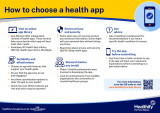Post-traumatic stress disorder (PTSD) is a psychological reaction to experiencing or witnessing a severely shocking event. It means getting stuck in re-experiencing a traumatic event. Your body and mind act like the event is still happening, right now, even though it is in the past. It keeps your body in a fight or flight response.
PTSD can lead to depression, self-harm and suicidal thoughts. If you or someone you know might have PTSD, it’s important to get help. Read more about PTSD.
Here are a few PTSD apps reviewed by Healthify
Before choosing an app, think about how it will benefit you and what you want it to be able to do.
- An app will only be helpful if you use it, so it needs to be something you like using and find easy to use.
- If you find the app difficult to use, or you don't like the imagery or look of it, or the language it uses, you may want to find another one that suits you better.
- For more guidance on how to choose health apps, see below, PTSD apps – help me choose and How to choose a health app.
- It's important to remember that apps don’t replace professional help or your doctor’s advice.
| App | Features | Clinical review |
|
|
|
|
|
|
|
|
|
|
|
PTSD apps – help me choose
There are a variety of apps aimed at supporting people with PTSD. These apps differ in their features and functionality. Choosing between the apps is challenging because many of them have been developed without any input from healthcare professionals or objective assessment.
A recent study outlined the following treatment and self-help methods for PTSD:1
- Psychoeducation
- About stress responses and reaction to trauma
- About strategies of managing arousal and flashbacks
- About safety planning
- Emotional regulation and coping skills
- Acquisition and consolidation of cognitive, behavioural and social skills
- Skills to reduce and control arousal, distress and anxiety
- Cognitive processing, restructuring and meaning making
- Affirmations.
- Thought stopping, removing problematic cognitive strategies.
- Analysing the meaning of the event; writing a trauma narrative.
- Processing trauma-related emotions & beliefs
- Processing emotions (eg, shame, guilt, anger)
- Targeting beliefs (eg, safety, trust, power-control, esteem)
- Training to challenge distorted beliefs about the event
- Adaptive reappraisal of trauma – generated beliefs about self and others
- Reorganisation of memory processes
- Elaboration and processing of trauma memories
- Correcting autobiographical memory
- Identifying triggers for flashbacks
- Imaginal and/in vivo exposure
- Preparation (eg, building a fear hierarchy)
- Help to reduce or overcome avoidance
- Exposure to traumatic events
- Written exposure recounting the trauma
- Breathing retraining
- Relaxation exercises
- Eye movement desensitization and reprocessing (EMDR) related exercises
- Bilateral eye movements during sustained recall of trauma memories
- Attention to a back and forth movement or sound
- Self-care and structuring of everyday life
- Healthy diet
- Exercise (increasing physical activity)
- Sleep regulation
- Daily structure
- Energizing activities
- Accepting support and asking for help from others
- Expressing personal needs
- Verbalising feelings
- Appreciating good intentions from others
- Homework assignments
Learn more
Apps for PTSD(external link) PsyberGuide






